Sunday, April 29 – Pamukkale to Fethiye
Went to the garden for our last breakfast at the Allgau. It was sad to say goodbye to Ummu and her family. Ummu and her mom were checking the roses in the garden. What a sweet family.
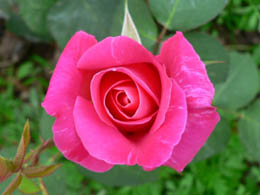
A Rose from the garden |
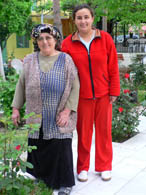
Ummu and her mom in the garden |
Steve and Janice (from Nova Scotia) joined us for breakfast. Kasim was wearing a tee-shirt that said “I am from Mars” as he served us breakfast. I was worried about Kate and Mardi who were taking the same bus to Fethiye as Bill and I. They finally came down about 8:45. They had been out most of the night partying with Adam and Kazim. Australia won the Cricket World Cup and they were celebrating Australia’s victory with two bottles of vodka – Girls – GIRLS!
Mehmet took us guests (Kate, Mardi, Bill and me) to the bus station. Others (Kasim, Adam and Mehmet’s daughter) hopped in the van to come along to say “good-bye.” Turkey is a very friendly place. It began to rain fairly hard. Mehmet said he wanted to sit in his favorite café with the big window and watch the rain and drink tea. They waited with us in the rain until our bus came to take us to Denizli. At Denizli we boarded a larger bus to Fethiye. We sat in the front seat. Across from us was a Grandma with a little boy about 6 or 7. He sat quietly and held his Grandma’s hand (not at all like my little Zizi).
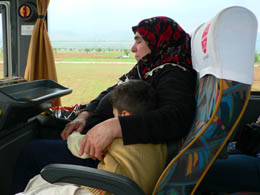
Asleep on the bus |
On the bus ride, Kate and Mardi showed us the video they took at Pamukkale where they pretended to be penguins (like the lines of tourists heading up the travertines). Silly is good and they are very good (or is it bad?)!
It was a nice, slow bus ride over dramatic mountains and through valleys filled with orchards and farmland. We saw row after row of plants. Then, in a corner of a field, we’d see one lonely figure with a hand tool working the land. It rained for most of the four-hour bus ride, and even snowed as we crested one mountain pass. Great travel day.
We got to Fethiye and were immediately barraged by people wanting to take us to their hotel or sell us a tour. Someone from our hotel—the Artemis (which Mehmet at the Apricot in Istanbul arranged)—was supposed to meet us, but was nowhere to be found. A rather pushy guy told us that our hotel had called him. He said we were supposed to take a minibus and the hotel would cover the cost. We waited for 15 minutes until the minibus left the bus station. The minibus stopped at the bottom of a hill. The driver pointed to about 6 flights of steps. No one from the hotel was there to help with our luggage, so we dragged our bags up the steps. At the top of the steps we had to ask where the Artemis was. We were so disappointed -- It was shabby and run down. We did get a room with a beautiful view of Fethiye Bay, but nothing in the room worked. No hot water, broken TV, broken hairdryer, broken towel rack, broken refrigerator, leaking toilet, burned out light, filthy carpet, mildew all over the bathroom, musty smell. Bill was mad at himself for letting Mehmet in Istanbul book this hotel, instead of properly researching and booking the hotel himself. To make matters worse, we had prepaid for four nights. Bill walked down the street to check out the Hotel Daffodil that was recommended in Frommers. He thought it looked good.
We had a beer on the terrace of the Artemis. The terrace was pleasant with nice views. Shawn, the hotel clerk, came up to see how we were doing. She was friendly and introduced us to the hotel’s cook. Shawn called her “Mama” and said she was a very good cook. Let’s hope so! (We desparately want something to be good about this place.)
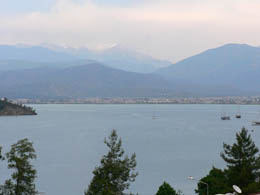
View of Fethiye Bay |
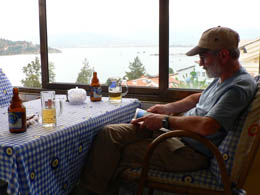
Bill drinks a beer and studies his guide books |
We walked into town along the beautiful bay, filled with yachts. Our “girls” from Australia, Kate and Mardi, were there. They had picked up an Australian guy, Gregory, who was built like a gladiator. Gregory teaches elementary school and races sailboats. We had another beer with them at an outdoor café on the marina (the Park Café Restaurant, Kordon Boyu Iskete Yani, Tel: 614 94 23)—a beautiful setting.
Bill and I went into town to look for souvenirs. Bill always hates shopping. The sky opened up, bringing more rain. We headed back to our hotel. On the way back, we passed the Aussies, who were on their third or fourth round. Those kids can party!
At the hotel, Mama’s dinner was, indeed, good—stuffed peppers, potatoes and white bean salad. We were the only guests. The hotel employees, Shawn and her boyfriend Reggie (the hotel manager), and a couple of other Turkish guys, ate together family style.
After dinner Bill and I wanted to check CNN on the large-screen TV to learn more about the political upheaval in Turkey. There had been a demonstration of over 1 million protestors in Istanbul and the military was threatening to take over the government to stop the election of an Islamic president. The hotel employees didn’t want to change the channel until their soccer game was over.
Bill asked Reggie about the progress on repairing the hot water. The system was broken and the small amount of hot water from the solar system was all used by Reggie, Shawn and the other hotel employees. They had their hot showers – we did not. Reggie said that the hot water would not be fixed until tomorrow. Bill suggested that the hotel should compensate us for our inconvenience. Reggie became angry and belligerent, never apologizing for our lack of hot water. Finally, the other employees dragged him away to calm him down. Reggie called his partner who suggested that the hotel not charge us for our dinner. Any good will from this gesture dissipated with Reggie’s continued hostility.
We went to bed in the depressing, musty room. The conditions kept Bill awake much of the night.
Monday, April 30 – Fethiye—Kayakoy to Oludenez
Awoke to beautiful weather and the Internet forecast promised sunny skies, not the unstable weather Shawn insisted was coming. Bill and I walked to the Daffodil Hotel. They said rooms were available, in case we want to change. We went back to the Artemis for a nice breakfast, served by a very nice Turkish guy. Shawn came by and asked how we slept. Bill replied, “Not well,” followed by a long silence. I filled in the pause with “Oh, Bill has asthma and the musty room got to him.” The battle is still on.
After breakfast Bill and I discussed whether we should call Mehmet in Istanbul and ask him to change our hotel. We decided to go on our planned hike and deal with the hotel situation when we returned.
We walked to town and stopped at the Visitor’s Information Office to ask about hiking from Kayakoy to Oludenez. The helpful information lady said it was a nice hike, but to be sure to follow the white and blue color-coded trail markings and NOT the red markings (information we later found to be incorrect).
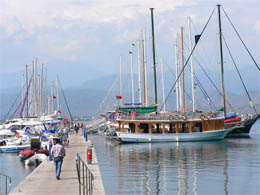
Morning in Fethiye |
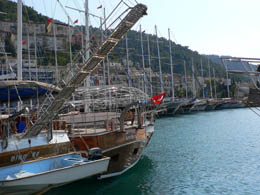
Yachts a’plenty |
We walked to the Mosque where dolmuses (minibuses) leave for Kayakoy. (“Dolmus” means “stuffed” in Turkish—the busses don’t leave until they are stuffed with passengers). The $2.00 fare got us to the gate of the Kayakoy ghost town.
Kayakoy had been a thriving town for hundreds of years, but now it lay abandoned, an eerie ghost town. Most of the residents were of Greek descent. When Turkey won its independence in 1924, there was considerable hostility between Greece and Turkey. So the leaders hatched a plan for a population exchange between the two countries, with the Greek Orthodox people being repatriated to Greece, and the Turkish Muslims being sent back to Turkey. Approximately 250,000 Turkish people were involved. It was devastating to both the Greeks and Turks who were “exchanged.” They were forced to leave their country of birth (and ancestor’s home) and make a new life in a foreign place. I was struck by a sign posted on a decaying building – “Goodbye to 600 years of peacefully living together.”
The village of Kayakoy was never re-occupied after the Greeks left, even though the town had many houses and churches. Today, people still have the deeds to their grandfathers’ houses in Kayakoy, and when the EU Membership becomes final, perhaps they will reclaim these properties. In the meantime, Kayakoy remains empty.
We walked on the winding marble path through the town and through history in this eerie abandoned village, imagining the sadness the Greek people felt having to leave their town of 600 years – a beautiful, prosperous town perched on a hill overlooking a rich farm valley with views of the Mediterranean just over the hill.
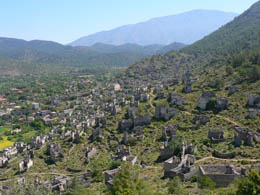
Kayakoy |
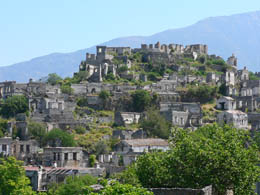
Kayakoy |
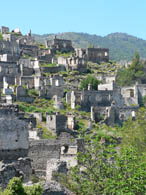
Kayakoy |
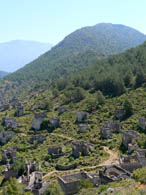
Trail through the town |
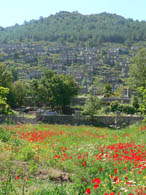
Red poppies everywhere |
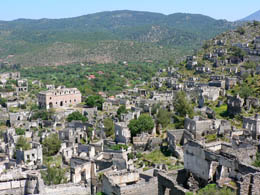
Kayakoy |
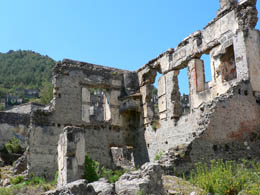
Once somebody’s grand house |
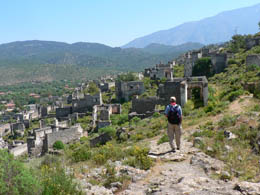
Bill walks through the town |
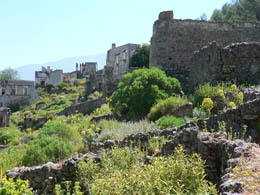
Once a neighborhood |
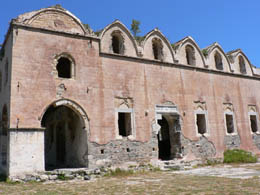
Greek Orthodox Church |
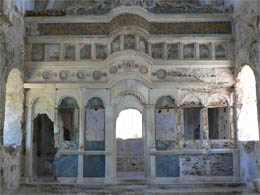
Somebody’s grandparents were married here |
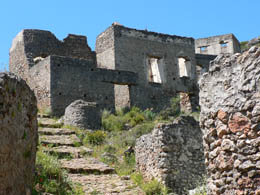
What’s left of the neighborhood |
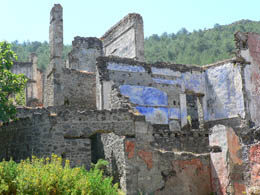
More ruins |
We asked another couple we met which color trail markings to follow to Oludenez. They had done the hike the day before and said to follow the red and yellow markings. The 5-mile trail was partly on the ancient Lycian Way. The trail went over a ridge, through spectacular scenery with carob trees, sharp cliffs and blue waters below. The incredible views of the Mediterranean and Oludenez beach are the prettiest in all of Turkey. (Lots of Britons are buying property in this area either for retirement or as second homes.)
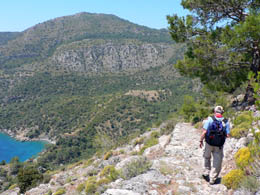
Bill hiking on the Lycian Way |
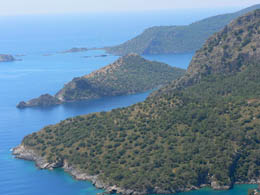
Blue Mediterranean |
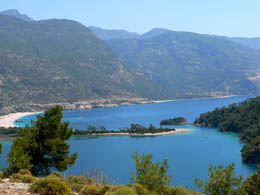
Blue Lagoon |
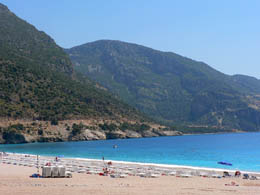
Oludenez Beach |
As we descended to the resort town of Oludenez, we saw the big, wide, beautiful, empty beach with paragliders soaring overhead. It was almost 3:00 and I was famished. I had pasta and Bill had a sandwich at the Oba Restaurant, a block from the beach. After lunch, we caught a dolmus back to Fethiye, wondering if the hot water at the hotel was fixed.
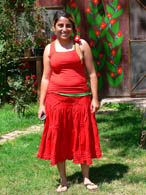
Oba Restaurant |
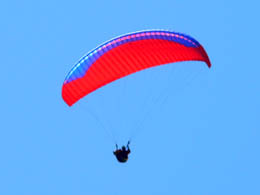
Paragliders overhead |
When we arrived back at the hotel we couldn’t find any staff and our room was just as we had left it in the morning, untouched by any cleaning staff. Not even fresh towels. That was the last straw. We headed to the Daffodil, checked out their rooms and then called Mehmet in Istanbul. Mehmet, like a real champ, immediately said that he’d arrange for the change to the Daffodil, no questions asked. Mehmet asked to talk to the manager at the Daffodil to arrange payment (since we had already paid for the Artemis). Although the Daffodil was more expensive, Mehmet covered the difference. The Daffodil said they would send a car to pick up our luggage at the Artemis. We walked back to the Artemis. The staff had returned. Bill gave Reggie, who was lying on a sofa with his feet up on the desk, 5 lira to cover the cost of the Internet. He took the money and grunted. As we collected our belongings from our room, our waiter from breakfast came by to see how our day had been. When he discovered we were leaving he said he was sorry about the situation. Reggie and the others could take some lessons from his lovely style.
The car from the Daffodil picked us up and within a few minutes we were in our fresh, new digs, where everything worked and the staff was professional. We both took a nice hot shower and watched some BBC news on TV.
We walked back to the marina and had a beer at our favorite outdoor café—the Park Cafe. Beautiful scenery, beautiful weather! Life is good again.
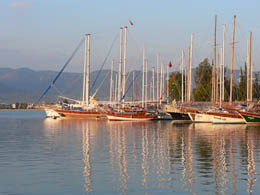
The bay in Fethiye – Man-oh-Man! |
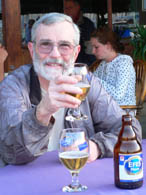
Life is good (and so is the Efes beer) |
We walked to the fish market where you can purchase fresh fish and take it to one of the many stalls where they will cook it and serve it with a salad and veggies. We chose Cem & Cam’s stall, because it was recommended in Frommer’s. Unfortunately, a huge group of Aussies came in right after us. We had to wait forever for our cooked fish to arrive, while other diners who arrived after us were served. When our fish finally arrived, it was delicious in spite of the wait.
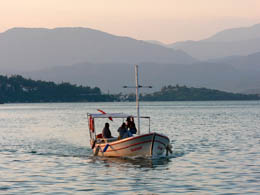
Waiting for our boat to come in! |
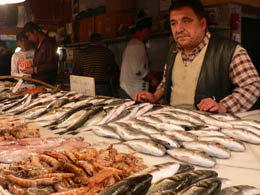
Happy (?) little fish vendor |
On our way back to our hotel, we walked by a mosque just as the call to prayer was sounding. In the old days the call was made by someone who climbed up the minaret. Now most mosques use a recording. This mosque had a terrible sound system. Back at our room, Bill did the laundry while I caught up on my journal.
Tuesday, May 1 – Fethiye—Saklikent Gorge
Breakfast at the Daffodil was disappointing—hard boiled eggs and Tang! But the view was lovely.
We walked into town to catch a dolmus to Saklikent Gorge. On the way we stopped to buy water and postcards, and to say “Hi” to our friend at the Visitor Information Office (and tell her the correct markings to follow for the Kayakoy to Oludenez trail).
We paid about $4.00 each for the one-and-a-half hour ride to the Gorge. We chatted with a young British guy and his Turkish wife, who were on their way to see some ruins. We showed them our postcards with photos of the Saklikent Gorge and they decided to come along. The drive to the gorge was wonderful after we got past the city and suburbs. The scenery reminds me of Tuscany.
We arrived at Saklikent Gorge and paid $1.50 each to enter. We walked down a wooden bridge suspended over the rushing chalky turquoise river below. Then we got to the place the travel guides said served delicious fresh fish from the river, but it hadn’t opened for the tourist season yet. At that point most people turned around and headed out, but we were determined to hike up the gorge.
Bill stripped down to his bathing suit and I unzipped the legs on my pants. To get down the gorge you had to enter the river next to a large waterfall, and walk upstream in icy, knee-deep water rushing fast enough to knock you over. Several people had entered the water before us only to retreat. We walked slowly against the current hoping our Tevas would hold. I bit my lip, but made it. We both had trouble staying upright, but were determined not to fall into the raging water with our cameras in our backpacks. Once we passed the waterfall, the rest of the river wasn’t so precarious. After awhile we got used to the river—the cold water, swift currents and rocks. People watched us from the landing. After we made it past the waterfall, the couple we had met on the bus decided it must be safe if people older than their parents could do it. She was wearing high-heeled sandals and carrying a purse and a shopping bag. Her husband told me that Turkish women are very hesitant to take such risks. The four of us hiked deep into this amazing canyon, as it got narrower and the current stronger. At times the span of the canyon walls were only an arms length apart with huge boulders wedged directly overhead. About a mile down the gorge we came to a waterfall. We couldn’t go farther without getting soaked, so we turned back. On the way back the Turkish woman slipped and went down into the rapids, leather handbag and all. Her sweet husband pulled her up. She was such a good sport, laughing all the while. We were all having a grand adventure.
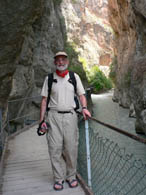
Walking on the suspended bridge over the river |
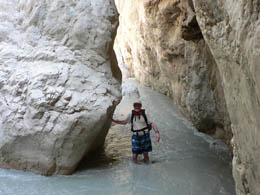
Hiking in the chalky turquoise water |
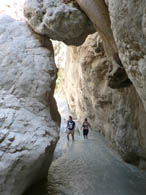
Brave young couple with boulders overhead |
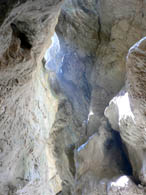
Filtered light overhead |
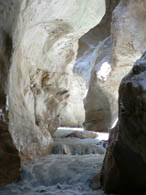
Rushing waters below |
After the hike, we walked back to the bus stop to catch a dolmus back to Fethiye. The road was lined with vendors – “Please, have a look.” I bought my gourmet friend, Lolly, some Turkish bay leaves before we left.
Back in town, we looked desperately for an Internet café, but the only one we found was closed. At 3:00, we stopped at a restaurant called the Duck Pond in the Bazaar to share a beer and a little pizza. Bill found a Magnum. Clouds were moving in and the wind was picking up. We walked another mile or two to the Tuesday Market, with stall after stall of fresh produce, spices, Turkish Delight, clothes, trinkets, jewelry, rugs, leather goods and artwork. We bought some pistachios and a blouse for Amy.
We walked back along the bay, still looking for an Internet café. When we made it to our favorite watering hole (the Park Café), we stopped to split another large Efes beer. The waiters, with whom we’d become friends, were playing with a local dog. Seems that every bar or restaurant has its own dog whose job is to hang out and beg for food.
It started to rain so we dashed back to our hotel—a mile away—to get our laundry in from the balcony. We checked our emails on the computer at the hotel (for $4.00 per hour). Got a note from Amy—Zi learned to ride her two-wheel bike, and had her painting of an angel hung in Amy’s church.
We showered and watched a little BBC news—Turkey’s Supreme Court overturned the election of the Islamic president. Not enough information to know exactly what’s going on, but we hope this will reduce the risk of a military coup.
We caught a dolmus back to town for a lovely, quiet dinner at the Megri restaurant. We walked back to our hotel in the rain, enjoying the sound of the raindrops on my umbrella. We are expecting the storm to pass by tomorrow. (We’ve been so lucky with the weather so far.)
Wednesday, May 2 – Fethiye—12-Island Cruise
After another mediocre breakfast at the Daffodil, we walked to the marina to negotiate a price for a 12-Island cruise. Because tourist season hasn’t started yet, we negotiated a price of $16 per person for an all day cruise on a sailboat, including lunch. We had a few minutes to shop before we boarded. I bought a simple aggott necklace, then snapped a few photos of Bill next to a large poster of Ataturk, the Turkish version of our George Washington – saved the country, saved the day – a real national hero. (Ataturk reminds me of Count Dracula—stern and menacing). The park was loaded with posters of Ataturk going about his typical heroic day.
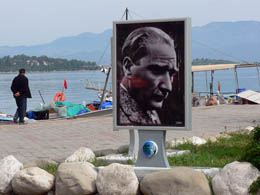
Down by the bay with Ataturk |
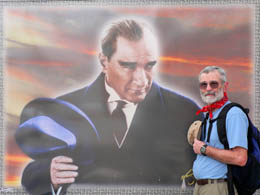
Two heros |
We boarded our sailboat at 10:00 and claimed a puffy mat on the bow. Only 15 passengers; in summer, the boat would carry 45. We liked our shipmates:
- Steve and Susan from Yorkshire, England. Susan and I led the others in some yoga.
- Ruth and Martin, also from England, on a getaway from their four kids and to celebrate Martin’s 50th birthday. He works as a scaffolder; she helps people in Africa. He was the funniest guy I’ve ever met.
- A young woman from Wisconsin, who had converted to Islam and was traveling on her own.
- A young, romantic couple from Poland.
- Terry and Inga—Inga was a large woman with strange tattoos of vines growing over her back and arms. Terry was a skinny man with pierced nipples.
The boat ride was uneventful; actually kind of boring. I took photos and finished writing postcards. We stopped at several islands for a swim, but Bill and I stayed on the boat. Cleopatra came to one of the islands for her Spa treatments. She must have had very nice skin. Mark Anthony gave Cleopatra the entire Turquoise Coast as a wedding gift and the Baths are mentioned in ancient documents. At one island we got off and hiked around and then the dinner bell summoned us for lunch. It was surprisingly good—fresh fish, salad and spicy curried potatoes.
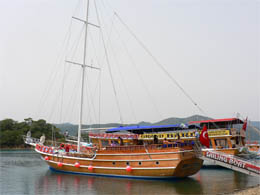
Our sailboat |
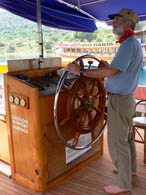
Our pretend captain |
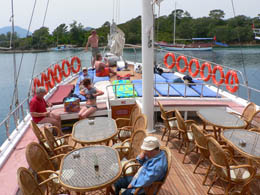
All hands on deck |
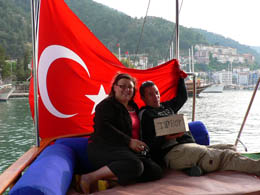
Our crewmates (Ruth and Martin) |
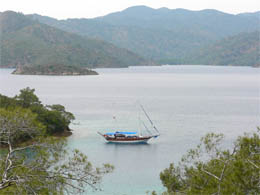
Stop for a hike |
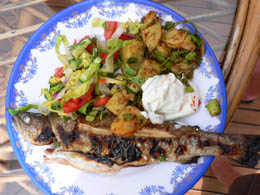
Yummy lunch |
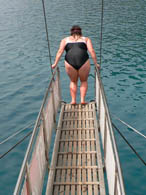
Person overboard (Ruth dives in) |
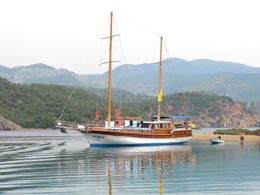
More 12 island stops |
On the way back the crew cut the engine and we sailed for a couple of hours. It was nice to hear only the wind in the sails and the lines hitting the mast. Everyone was so relaxed. Some (including Bill) were even snoring. It was a very peaceful scene, but tough for two type A personalities.
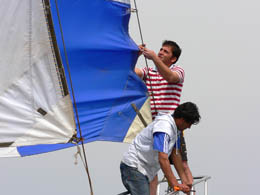
Hoisting the sails |
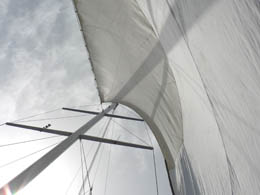
View from a prone position |
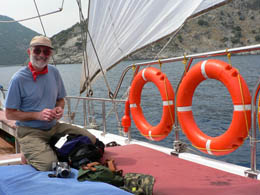
Bill, not good at napping |
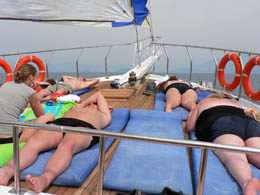
This is the life |
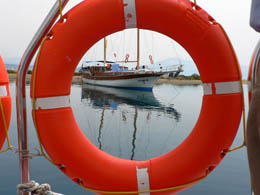
The money shot |
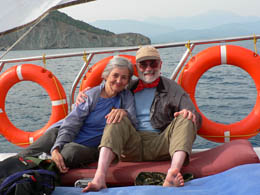
Two Type A’s pretending to relax |
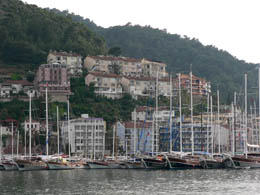
Day is done |
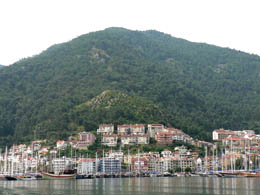
Back to Fethiye |
At 6:30 we arrived back at the dock. We said “Goodbye” to our new friends and hurried to the government crafts shop. There were some nice things, but Bill wasn’t happy shopping. With his critical “I-need-a-beer stares,” I just couldn’t focus, so I gave up without buying anything.
We went back to our hotel to arrange tomorrow’s bus trip to Cirali. We checked the Internet—another email from Amy (our garden is bursting with strawberries). We showered and walked back to the Park Café for dinner. We had a huge meal on the marina. We’ve gotten to know the waiters. They kept bringing us stuff “on the house” (appetizer, special bread, apple tea). The entire meal for both of us came to $16, including beer. The waiter said Myla, their local dog, had been naughty, and had to be punished (tied up away from the tables). She hates being away from people. We’ll miss this place and even that stupid dog.
We walked back to our hotel for the last time. We’ll miss saying “Hi” to the guards at the military police station with their automatic weapons. We saw several cars with large Turkish flags draped over their tops speeding through town. Hope that doesn’t signal trouble. Back at our hotel we organized our stuff for our next adventure tomorrow.
Thursday, May 3 - Fethiye to Cirali
We had breakfast at the hotel and then pilfered a couple of pieces of bread and some cheese for lunch on the bus. A minibus picked us up at the hotel and dropped us at the otogar (bus station) to catch the 9:30 bus to Olympos/Cirali. We spent the next 5 hours on the road with mostly locals, hopping on and off the bus. One guy had such bad B.O. it gave us a headache. We were relieved when he chose a seat in the back of the bus, away from us. The first couple of hours on the bus were not very interesting, so I read my book. The bus stopped at Kalkan, Kas and Demre (where St. Nicholas, aka Santa Clause, is from). There were a lot of tourists going to the Church of St. Nicholas. Demre appeared to be a tacky tourist town with a statue of Santa Clause in the square and billboards with Santa and a surfboard showing the direction to the beach. (Glad we didn’t plan a stop to do the Santa-thing.)
The scenery on the winding road along the Mediterranean was spectacular—steep cliffs, turquoise sea and sandy beaches. It was like driving on California’s Highway 1 fifty years ago—no development, just plain beauty. Bill shot some video and I watched the driver who looked like he was about to nod off. I plotted my escape in case the bus skidded off the narrow road and plunged into the ocean below.
I got interested in my book again and didn’t even notice when we made a stop to let armed military police board the bus to check ID’s. Bill showed the policeman our passports, but he wasn’t satisfied until he saw our Turkey Visas. The policemen took all the Turkish ID cards to his car where each ID was carefully inspected. The ID’s were returned and we were on our way again.
The bus driver let us off at the Olympos Bus Station, telling us it was the right place to get off even though our tickets clearly stated “Cirali.” People were boarding a dolmus so we asked if it would take us to Cirali. Nope, the dolmus was going to Olympos, not Cirali. We were directed into the bus station (actually a restaurant) were the proprietor told us that there were no dolmus going to Cirali and we would have to hire a taxi for 35 lira (about $25). We were pretty upset because that was what we paid for the 5-hour bus ride from Fethiye. We later learned that the bus driver gets a kickback for dropping Cirali passengers off at the wrong bus station and then they have to pay for an expensive taxi ride. We acquiesced to this extortion and took a taxi to our hotel—the Canada. Saban, the owner of the hotel, greeted us.
The Hotel Canada is a wonderful place with a gorgeous pool and a manicured garden in a country setting. Saban grew up in the house adjacent to the hotel. He worked in Miami for a while, married Carrie, a Canadian, and spent a few years living in Calgary before returning to Cirali to open the hotel. His wife and two kids (9 and 13) live 50 miles away in Antalya, where the kids go to school (there is no school or bank or post office in Cirali). Our room was very clean, with a beautiful, newly-renovated bathroom and a balcony overlooking the garden. At 4:30 in the afternoon, we shared a beer next to the pool.
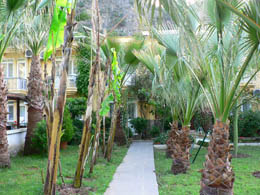
Hotel Canada grounds |
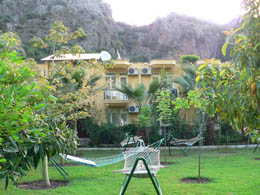
Hotel situated in a peaceful valley below the mountain |
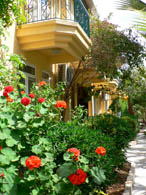
Pathway to our room |
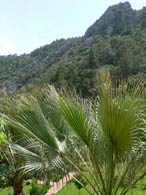
View from our balcony |
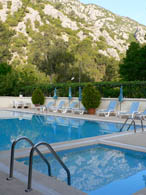
Most inviting pool in all of Turkey |
Saban told us he was grilling chicken wings and sausage for dinner that night and invited us to join him at 7:30. We had no idea that he was an incredible gourmet cook. We thought he would just do a “Guy BBQ thing.” (We were in for a real treat.)
Saban loaned us a couple of bikes and we rode into “town.” (Town is a few shops and cafes.) I bought earrings from a local glass blower and Bill had a Magnum. The jewelry shop was “the read deal” – no tacky trinkets. Their jewelry is inspired by the turquoise Mediterranean Sea just a few blocks away. (I only wish I had bought more amazing pieces.)
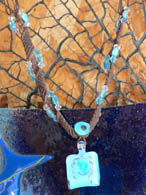
This necklace could have been mine |
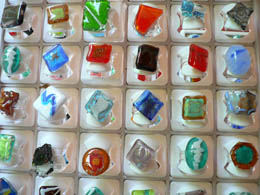
Amazing rings |
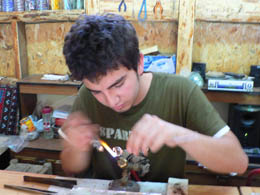
Artist at work |
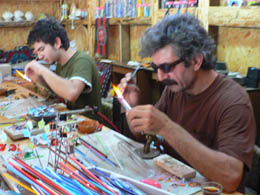
Artist at work |
We rode around the countryside for about 1 ½ hours, passing farmers, chickens, a mosque, and a very unfriendly barking dog and then headed back to our hotel to check the Internet before dinner. I caught up on my correspondence while smelling our wonderful dinner cooking on the grill.
At 7:30 Bill and I sat down with Saban by the pool and had one of our best meals in Turkey. We had a nice chat with Saban and learned about the area and his family. When we asked him how much we owed for the dinner, he said, “Nothing, I invited you as my guests.” The Canada hotel is magic. Bill picked a great spot. Tomorrow we’re off to the ancient city of Olympos and the beach.
Friday, May 4 – Cirali and Olympos
Roosters woke us up at 5:00, but got back to sleep until 7:00. We went down for breakfast at 7:30. Saban served us a wonderful breakfast (our best in Turkey), including all the traditional Turkish breakfast food (tomatoes, cucumbers, bread, homemade strawberry jam, cheese, olives) plus steaming American-style pancakes (in our honor, I’m sure).
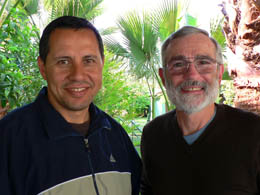
Bill and Saban |
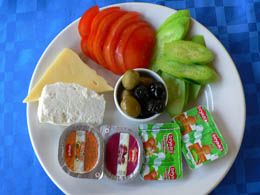
Typical Turkish breakfast (plus American on the side) |
We had an interesting conversation with Saban for a couple of hours over tea. We discussed the role of the Turkish military, Parliament, how the Turkish president is chosen and our own George Bush. (Saban said Bush looks like a naughty child who just got caught – insightful words.)
We packed up our cameras and walked to the beautiful Mediterranean beach, where sea turtles nest. We didn’t see any sea turtles, but we did see a handful of tourists settling on the beach. We hear a lot of French and German, but no English.
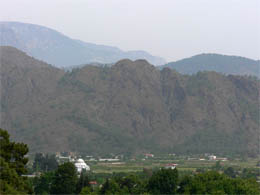
Cirali in the beautiful valley |
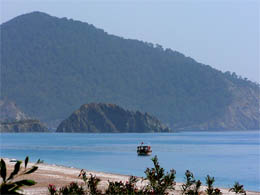
Cirali beach |
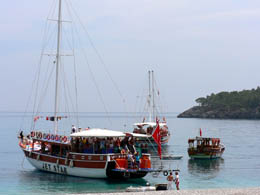
The boats have arrived
|
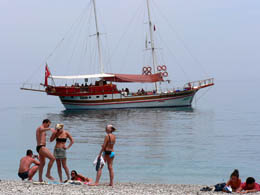
Beach day!
|
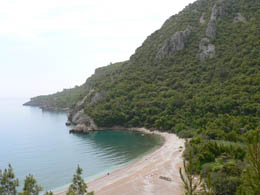
View of the beach from the ancient city of Olympos |
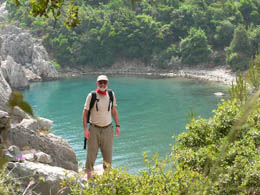
Bill on the edge! |
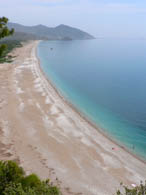 Cirali beach – once land of pirates |
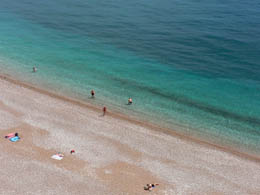
Now land of sun worshippers |
We found the entrance to the ancient city of Olympos, named after the sacred mountain of the god Olympos. We headed straight up the cliff to the acropolis for some pretty spectacular views. Olympos was once a prosperous port city. The city’s main thoroughfare was along a river valley that opens to the sea. In ancient times, before the silt built up, large ships entered from both sides of the city, which were lined with piers. A bridge connected the north and south parts of the city. The main settlement was in the southern part while graves occupied the northern part.
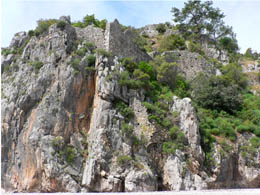
The entrance to the city somewhere along here |
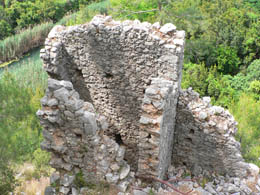
City walls perched on cliffs overlooking the sea |
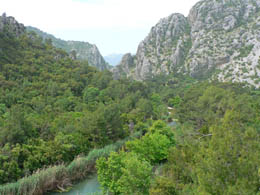
River runs through the city, once a huge port |
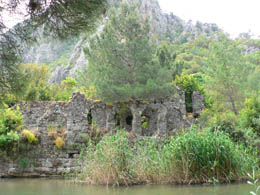
Arched walkways through town, once lined with piers |
Olympos – A Brief History
No one is sure exactly when Olympos was founded. The best guess is 11th Century B.C. Lycian coins (dated between 168-78 B.C.) were found here. It was one of the most important cities in the region because it had three votes in the Lycian League.
Like the other ancient cities, it had its fill of conquers and conquerees (my word). The Greeks were nicely settled when in 80 B.C. the menacing pirates, always a problem in this part of the Mediterranean Sea, conquered and destroyed the place.
A couple years later, in 78 B.C., the Romans came and conquered and rebuilt the city. (In 130 B.C., the Roman Emperor Hadrianus visited the place and loved it so much that he stayed for quite some time.)
Grand temples to Apollo, Zeus, Athena and Hephaistos were built during the Greek and Roman times. Christianity spread and took over where the Romans left off. They installed their archbishops and remodeled the temples -- ripping down a few pagan statues, adding a cross here and there and changing them into churches. The Romans managed to kill their first archbishop, Methodius. He became a martyr in the Christian world.
The city existed through the Byzantine era, but the Arabians destroyed it again in the 7th Century A.D.
During the crusades, along came knights from Venice, Genova and Rhodes to conquer Olympos and establish it as a vital fortress for the security of the crusaders.
Another invasion under Sultan Mehmet during the 15th century linked Olympos with the Ottoman Empire. After the medieval period (probably during the Seluck and Ottoman eras), the city was abandoned. It is now a mystical place lost among the trees. |
We loved the overgrown city with its temples, theatre (which we never found), burial grounds, and aqueducts. It’s in a jungle setting, with exotic bird sounds and a couple of land turtles munching on leaves. Where the sunlight could break through, wildflowers covered the grounds.
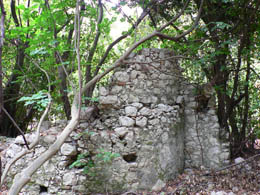
Ruins covered by the jungle |
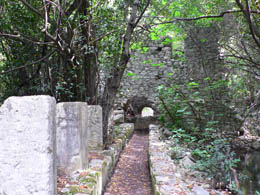
Serious system of aqueducts |
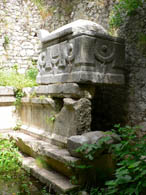
Tomb (or sarcophagus) |
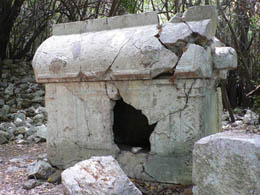
Another tomb |
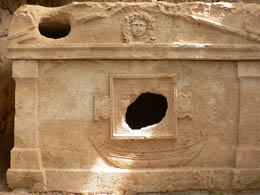
Ship captain’s tomb (note the carved ship) |
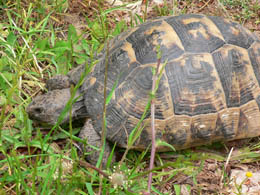
Land turtle |
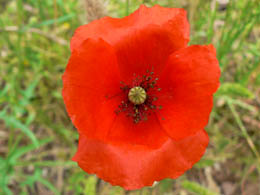
Red poppy |
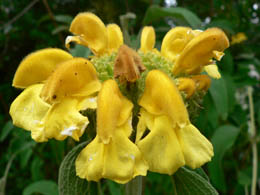
Unknown wildfower |
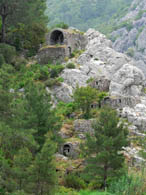
Guardhouse on a hill |
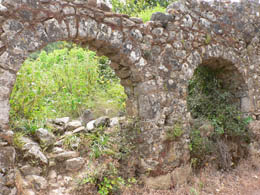
Those Romans with their arches |
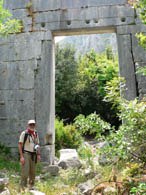
Bill guarding the gate |
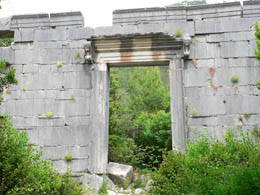
Massive gateway into town |
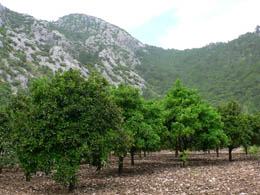
Orchards outside the gate |
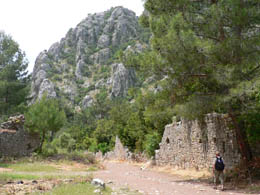
Main road through town |
We walked through the ruins and out the north entrance to the little town of Olympos, a backpacker haven, dotted with pensions and cafes. We picked out a café and watched two kerchiefed women make gozlemes, a Turkish pancake that is similar to a burrito. It’s made with thin dough and filled with your choice of meats, cheese, potatoes, onions, peppers, or spinach. We crawled onto a Turkish dining platform and ordered our gozleme with cheese and ground sausage. Bill had fresh squeezed orange juice and I had a beer. Only a few cafes were open and only a few tourists were in town.
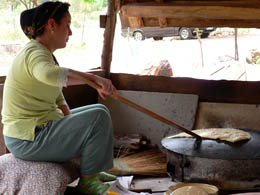
Cooking a gozleme |
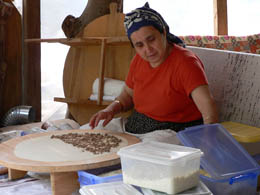
Preparing a gozleme |
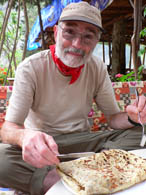
Eating a gozleme |
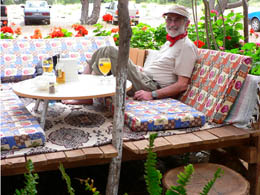
This is the life! |
We finished our lunch and retraced our steps through the ruins and beach to Cirali. We stopped in their two or three small shops. We bought Amy some hand-painted pants and Brian a Turkish shirt. We stopped by the glass blower’s shop and then Bill had his afternoon Magnum before we headed back to the hotel.
Saban and his friends were playing dominos. Looked like Saban was winning. They play for food, the loser invites the others over to his house for dinner – or they go out to a restaurant.
Bill and I had a quick dip in the huge pool. What a beautiful place, looking up at the tall trees and the two rocky cliffs overhead. We shared a beer, then checked the Internet. There was a message from Amy—always good to hear from her. A few other friends wrote to us concerned about the political unrest and demonstrations in Istanbul. Unaffected by the unrest in Istanbul, we felt perfectly safe in Cirali, safer than almost any place we’ve traveled in the world.
At 7:00 pm, Saban served us grilled sea bass, cooked with bay leaf and garlic inside. It was delicious. At 7:45 Saban drove us to the Chimaera, a cluster of flames that burn spontaneously from crevices on the rocky hillside. We climbed the steep trail and watched the burning fires above us. Methane gas comes whooshing out from deep inside the mountain and fuels the fires. The Turks speculate that this is the source of the Olympic flame. However, there is a similar place in Greece and Greeks claim theirs is the source. Whatever – this was a pretty amazing sight. The ruins of an ancient temple of Vulcan (the God of Fire) is perched on a ledge overlooking the Cirali valley and Mediterranean Sea beyond.
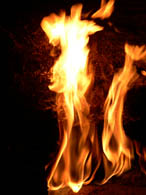
Chimaera flames |
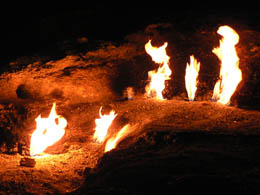
Chimaera flames |
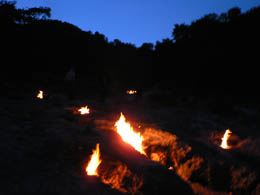
Rocky hillside covered with flames |
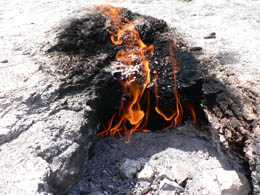
Chimaera flames by day |
There were only about a dozen people at the Chimaera (there are hundreds in the summer). A couple of people were roasting marshmallows and hotdogs over the openings that were spewing fire. We used our Petzl headlamps to find our way down. A young couple living in Sweden and their Turkish father walked with us because they had forgotten their flashlights. The Swedes has recently toured Viet Nam, following the same route we took a few years ago. We waited a few minutes at the food stand until Saban picked us up and drove us back to the hotel. A magical evening.
Saturday, May 5 – Cirali
Another wonderful Turkish-style breakfast, supplemented with fresh eggs over easy, followed by delicious French toast. We’re the only guests at the hotel. We feel like royalty. Saban is spoiling us rotten!
After breakfast and a nice chat with Saban, he showed us around his garden, pointing out the fruit trees (bananas, figs, citrus), and lots of other healthy-looking plants. Don’t know how he maintains it all.
Saban said he would take us on a hike. Carrie, his wife in Antalya, had apparently Googled our names and found our website. She told Saban that we like to hike and that he should go on a hike with us since he likes to hike, too. We hiked in the hills where Saban used to herd the family goats. We hiked for 8 miles, past streams and waterfalls, trout ponds, beautiful wildflowers, over a ridge, and back to the Chimaera where we had been the night before. It was interesting to see the fires during the daylight. Saban pointed out crabs, turtles, and picked some leaves for herbal tea, which he made for us when we got back to the hotel. From the ridge we could see the valley, beach and the turquoise Mediterranean. Saban showed us the ruins of the Temple of Vulcan, before we descended the steep slope, on huge marble steps. It was a gorgeous hike with a great guy.
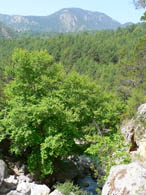
Our hike with Saban |
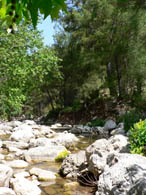
We crossed this stream |
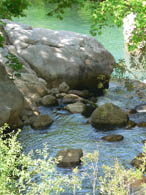
Saban spotted some trout in the pool |
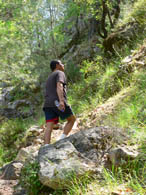
Another hill to climb |
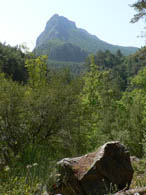
Spectacular views |
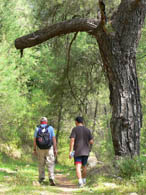
Hike through a forest |
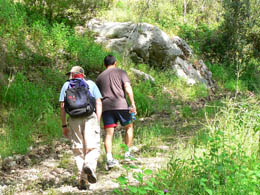
Walk this way |
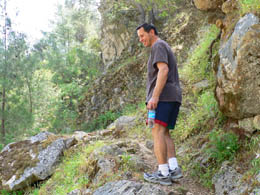
Saban leads the way |
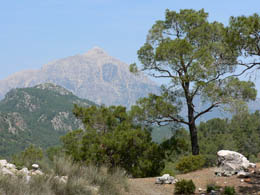
Mountains and trees |
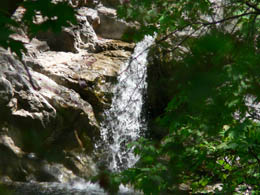
Rushing waterfalls |
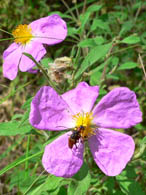
Wildflowers |
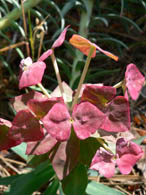
More Wildflowers |
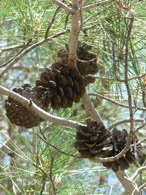
Pine cones overhead |
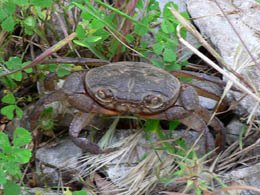
Lots of crabs |
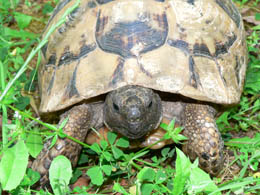
A few turtles |
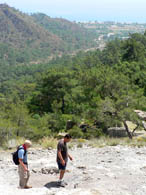
Another visit to the Chimaera |
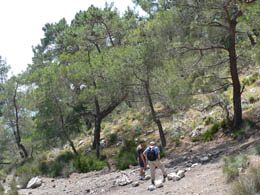
Checking out the Chimaera |
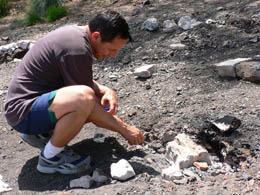
Saban shows us how to start a fire |
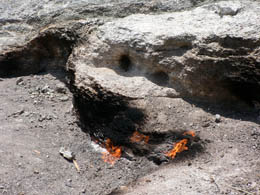
Plenty of holes to start a fire |
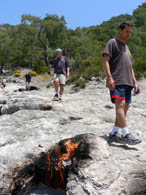
Hiking through the Chimaera |
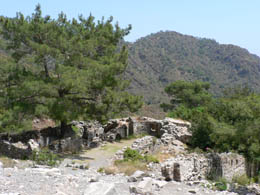
Ancient Temple of Vulcan |
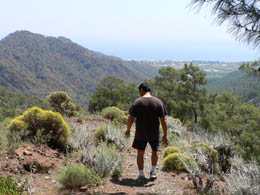
Saban leads the way back to town |
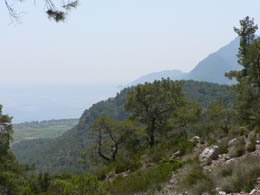
Down the mountain toward Cirali and the Mediterranean |
We stopped for lunch at Saban’s cousin’s café. We ordered gozleme stuffed with cheese, onions, tomatoes, and oregano. It was better than the one yesterday and much less expensive, including Saban’s lunch. We must have been given the family discount.
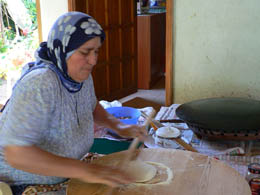
Making our gozleme at Saban’s cousin’s café |
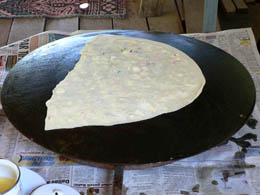
Deeee-lious! |
We stopped again at the glass blower’s shop. I liked so many things I couldn’t decide and ended up not buying anything.
We walked back to the hotel. I checked our email. Another message from Amy—always good to get. Saban brewed us herbal tea (from the leaves he picked on the hike). Then back to our room for a shower and some R&R.
Saban is excited about the big football game tonight. He says he gets so excited he yells and screams. He is passionate about his cooking, his home, his football team and his little boy, who has a birthday tomorrow (just like our little granddaughter Zi). Saban said that his son has an artist's spirit. He loves Spiderman. He makes friends easily and, because he speaks English, he can communicate with other children that come to the hotel with their families.
About 6:00 we grabbed the bikes for another spin around the countryside. We said goodbye to the beach (and the sea turtles we never saw), the little cafes (where women cook gozlemes for tourists on open fires), the little shops, the mosque, and the ghosts of marauding pirates. We found a lovely little piece of heaven right here in Cirali.
Back at the hotel, Mustafa (Saban’s helper) served us a beer. He divides it into 2 glasses. Bill and I always laugh over who gets the most. Back to our room to pack for tomorrow’s bus trip to Antalya.
At 8:00 we returned to the pool area for another huge and delicious dinner—tomato soup, salad, eggplant, ravioli with yogurt, chicken curry, rice and chocolate pudding. We’re going to miss Saban’s cooking. Saban says we don’t eat very much – although we feel we’ve eaten like a couple of pigs! Saban dashed off to watch the big football game on TV with his friends while we waddled off to bed.
Sunday, May 6 – Cirali to Antalya
Woke up in the middle of the night and couldn’t sleep, which means that I will be brain dead tomorrow. Hate when that happens.
As always Saban prepared a wonderful breakfast. The added specialty today: fried cheese rolls and scrambled eggs. Mustafa served us for the last time. We’ll miss this place. Saban told us he’d drive us to Antalya (we were planning on taking the bus), then he could stop by to see his wife and help cook for his son’s birthday celebration.
It was a warm day. The drive was lovely. It was Sunday and lots of families were having picnics.
Antalya is in a beautiful setting, surrounded by steep, rocky mountains on one side and the Mediterranean on the other, but the town is large (population around 1 million) and rather grungy. There was row after row of new, concrete apartment buildings. Saban drove us to our hotel, the White Garden Inn, in the Kaleici (Old Town) area. He had a hard time finding the hotel because all the streets are being repaved and many are closed or so narrow that if a truck is parked on the street you couldn’t get through. We said “Goodbye” to Saban. What a great guy. We’ll miss him. The White Garden is clean and adequate for one night. We are having withdrawal; the city is noisy and dusty, lots of traffic, loads of tourists and very aggressive shopkeepers.
We unpacked and then went in search of an ATM and the trolley to the museum. It was difficult walking down the street because of all the construction. We finally made it to Hadrian’s Gate, built in 130 A.D. to celebrate the visit of the Emperor Hadrian. We spotted a couple of other city landmarks--the clock tower (built on the city walls as part of the old city’s fortification) and the fluted minaret (built by some Sultan in the 13th Century) . We just missed the trolley and didn’t want to wait 30 minutes for the next one, so we walked the mile-and-a-half to the museum. The view of the marina was spectacular, but it was hot and we were glad when we finally arrived at the museum.
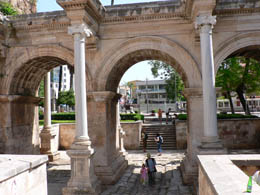
Hadrian’s Gate |
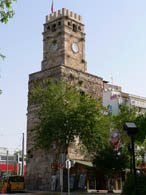
Clock Tower |
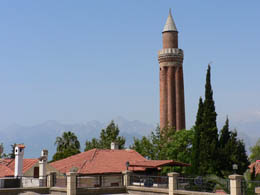
Fluted Minaret |
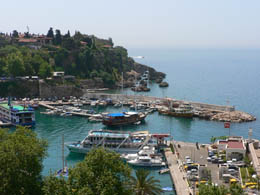
Antalya Marina |
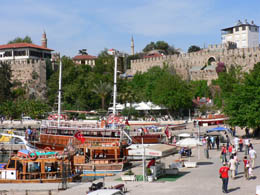
Marina below the city wall |
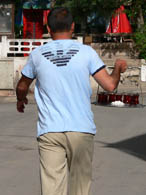
Tea runner – carrying tea on swinging tray |
The Antalya Archeological Museum is considered one of the top museums in the country. It has 14 rooms filled with unbelievably well preserved statues of Greek gods (Zeus, Apollo, Aphrodite), sarcophaguses (including a little one for a dog – 212 A.D.), coins, weaponry, burial urns, and other amazing artifacts. Much of the stuff was from nearby Perge, where we plan to go tomorrow. We were blown away by the place. First we went to the little gift shop, but a huge Japanese tour group was already there and buying everything in sight. So we decided to see the museum first and shop later.
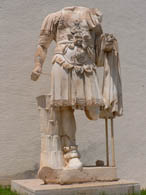
Outside the main door to the museum |
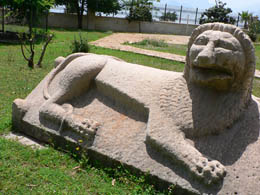
In the statue garden |
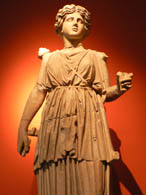
Statues |
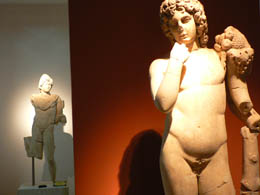
Statues everywhere |
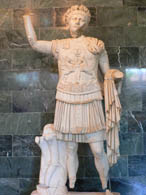
More Statues |
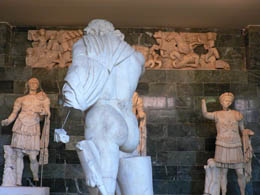
Nice buns |
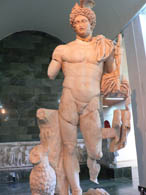
FTD God (wings on his head) |
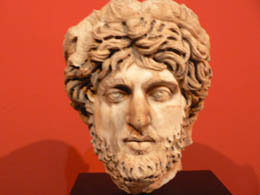
Nice hair |
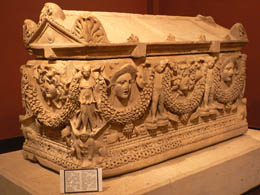
Sarcophagus |
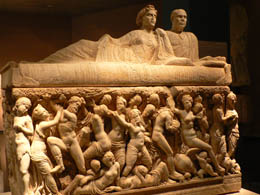
Husband and wife sarcophagus |
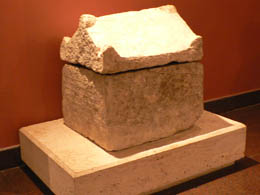
Sarcophagus for a pet dog
|
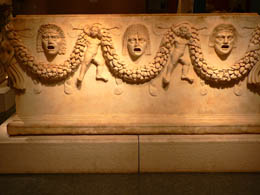
Sarcophagus for an actor
|
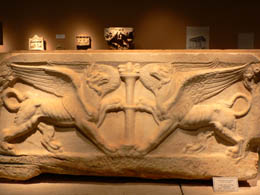
Sarcophagus with a new look |
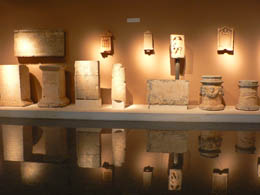
Wall of tablets of writings |
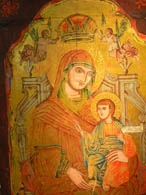
The Christians have arrived |
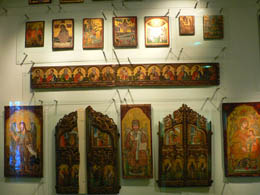
Wall of Byzantine religious symbols |
At 2:30 we caught the trolley back to Kaleici (the old town) where we found a quiet place for a chicken kebob and a beer. We walked down a row of shops where I ended up buying things before I knew the deal was done. Got some silver earrings—originally priced at $67, I got them for $30. I also bought painted bowls, nested boxes and an “antique” silver thing that Bill didn’t want me to buy. (It did speak to me.) We found a travel agency where, after much haggling, Bill arranged a tour for tomorrow to Perge and Aspendos.
I went off for my first Turkish Bath at the Balikpazari Hamami (hamami means bath), serving customers since the 12th century, for over 700 years. That’s what the brochure says.
I paid my $25 to get “the works.” Such a strange experience. I stripped down and was led through a series of rooms by two little hobbits yelling “sit”, “no here”, “good.” I felt like I was in a Nazi concentration camp being lead to the gas chamber.
A large group of women (probably from a tour bus) were ahead of me. They sat naked on benches along the walls while they waited for their turn to be scrubbed down on the center marble slab. It took forever to cycle through that group. I felt a little trapped as I sat on a bench in a hot, muggy room listening to dripping water and watching the steam rise to the foggy dome ceiling overhead. I did a little yoga stretching and then met Arlene, a real estate agent from Denver. Out of desperation, we bonded immediately and threw pans of water at each other. You get to know people really well when you’re both buck naked. Finally the two Nazi hobbits returned to scrub us and scrub they did! We laughed and giggled to avoid the pain. Then they soaped us down, rubbing layers of skin off us. They washed our hair, served us apple tea, and gave us an oil massage. Two or three hours later I’m all polished up, minus a pound of flesh and carry a couple of open wounds. Those mamas were tough!
Bill was back at the hotel waiting for me. He had found a little restaurant near our hotel that was recommended in both Frommer’s and Lonely Planet—Sim. It sounded good, looked good, but was disappointing. The food was bland and overpriced. (We’re probably spoiled by Saban.)
After dinner we took a walk around the busy, noisy town, dodging cars at every corner. How we miss the peaceful country village of Cirali. This place was crawling with groups of teens. The streets were torn up – major construction everywhere. We were afraid we might trip in the dark. I noticed that all the jewelry shops that were closed had removed the jewelry from their display windows, like they do in the states. After being hassled by vendors to buy more things and take boat rides, we finally went back to our room to try and regroup and recover from big-city life.
Monday, May 7 – Antalya (Perge and Aspendos) and night bus to Cappadocia
Had a nice breakfast at the White Garden patio. There were a couple of Aussie gals that I had bathed with in the Turkish Baths the night before. I almost didn’t recognize them with their clothes on.
The tour company picked us up at 8:50 for our trip to Perge and Aspendos. There were 6 of us on the trip: Joan and Elizabeth from Australia; a sweet couple from Belgium and Darry, our guide. Darry said the driver had just got his drivers license reinstated after a one-year suspension (I think he was kidding). Darry was an excellent guide. It was a hot day and sweat was running down his face, but nothing dampened his spirit. He was a natural born actor, storyteller and stand up comedian–-how lucky we were!
Our first stop was Perge, originally founded around 5000 B.C. The Greeks took over Perge after the Trojan War. In 334 B.C., Perge surrendered to Alexander the Great. Perge’s most prosperous era was during the 2nd and 3rd Centuries A.D. Most of the city’s ruins today belong to that era.
The well-preserved Roman baths were impressive. You could see the tile work on the floor as well as the heating system underneath. Hadrian, Emperor of the Roman Empire in the 2nd century A.D. spent time here. They built a gate in his honor, but not much is left. Darry explained how the water and sewer systems worked and showed us the troughs that were part of it. We saw the agora, where there had been 54 stalls arranged in a square with a temple in the middle. One interesting artifact was a marble sign for a butcher shop with a knife and hook carved into marble.
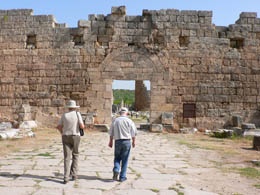
Darry and Joan walking to the city walls |
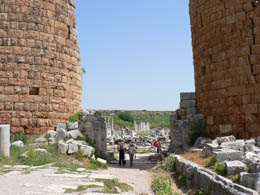
City Fortresses |
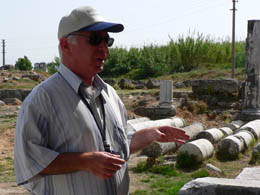
Darry tells us about the city |
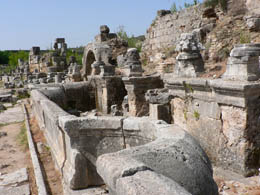
Once great statues and fountains |
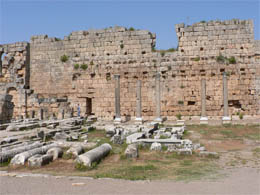
South Baths |
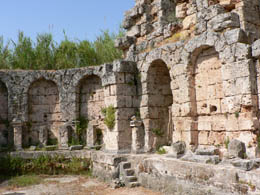
South Baths – Pool area |
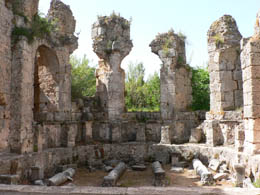
Baths |
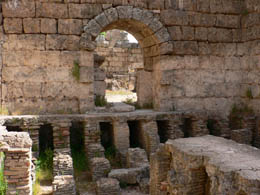
Baths – heating system in floor exposed |
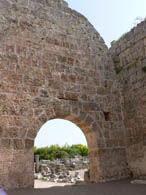
Bath exit |
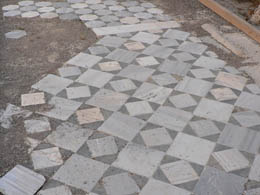
Bath - tile floor |
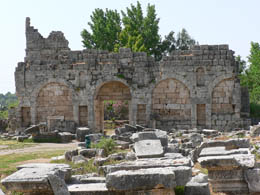
Perge |
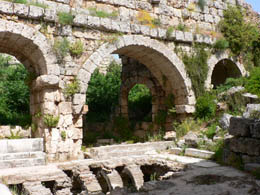
Baths |
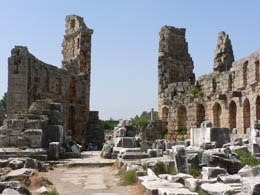
Perge |
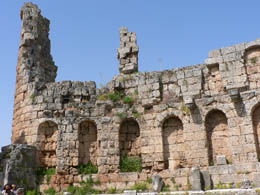
Perge |
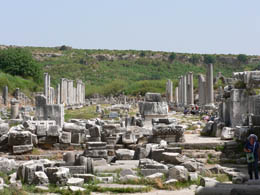
Marketplace |
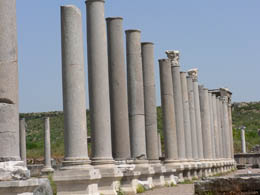
Columns by the agora |
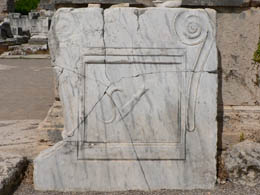
Butcher Shop sign |
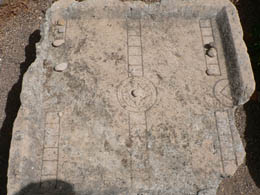
Roman board game (vendors played while waiting) |
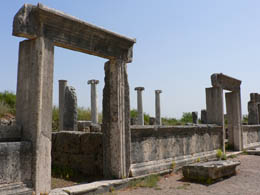
Marketplace |
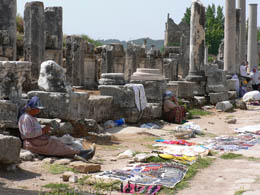
Marketplace with today’s vendors |
Women were selling things just outside the entrance—jewelry, scarves, hand knitted items, and belly dancing belts. I was intrigued, but afraid to get too close or I’d be trapped, even though the prices looked cheap.
We walked across the street to see the stadium. It was huge—69 entrances—each accommodating vendors when events were held in ancient times. They were setting up a stage for some event. The stadium was used mostly for athletic events—javelin, chariot races and, later, for gladiators and man-beast combat, along with Christians vs. lions.
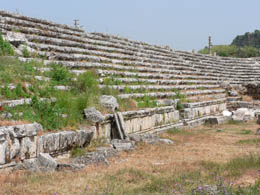
Stadium – days of glory are over |
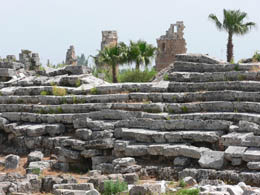
Stadium seating |
One of the best structures at Perge is the 15,000-seat theatre, but it was being renovated, so we couldn’t go in. It was a very hot day; can’t imagine this place in the summer.
Our next stop was the incredible Roman Aqueducts. From a distance you could see how the aqueducts spanned a huge valley, built from one hill to another, bringing water from the mountains into the city. The Romans designed the aqueducts to slope so gravity would create a continuous flow. Local women were waiting to sell cheap jewelry, embroidery, and other wares. One very old gal (probably about my age) got me for 1 lira for a safety pin with the evil eye symbol attached, but I got a good photo of her!
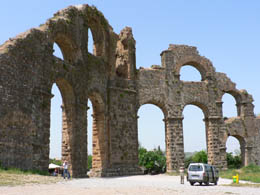
Only one section on the huge aqueduct |
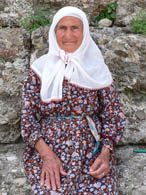
Sold me an evil eye safety pin |
From the aqueducts, we headed for Aspensos, with one of the best-preserved Roman theatres we’ve seen. It was designed by Zeno in the time of emperor Marcus Aurelius (161-180 A.D.). Two brothers (Curtius Crispirus and Curtius Auspicatur) built the theater as a gift to the city. Ataturk, the national hero, restored the theatre, but not without some controversy. This 2000-year-old theater is still used for ballet and opera performances during the summer. They were setting up the stage for a ballet when we were there. A three-story building stood behind the stage. At one time it was covered with statues. Now all that remains is a relief of Baccus, God of Wine. Darry showed us where walls were added to protect the audience when man-beast competitions were held.
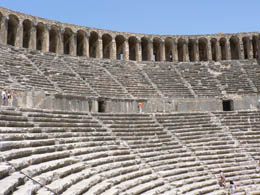
Aspensos seating |
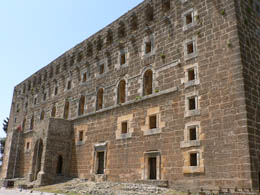
3-story building behind the stage |
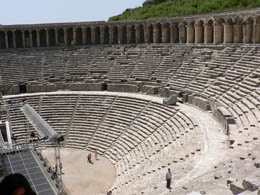
Seating |
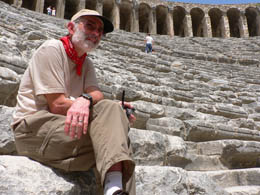
Bill relaxing |
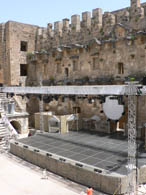
Stage |
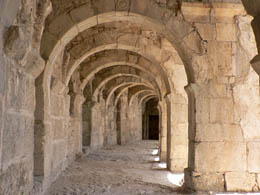
Corridors |
We stopped at a touristy place for lunch, but were pleasantly surprised by how good the food was (salad, starter, fish, rice and beer).
After lunch we went to a little farming village. Our first stop was a modest mosque. The women in our group covered our heads and then we all sat cross-legged on the floor and listened to Darry tell us about the prophet Mohammed. About 600 A.D. in Mecca, an ordinary guy named Mohammed started going to the mountain to meditate. Each day he would return to tell his friends about the images and messages he received up on the mountaintop. Instead of having him committed, his friends wrote down the messages, which eventually became the Koran. With these innocent daily treks up the mountain, Mohammed unintentionally started the Muslim religion. This upset a lot of Christians, who tried to kill him, but some miracle always saved him.
Darry told us about the Islamic traditions. Muslims always pray facing Mecca, which is usually designated in the mosque by a niche. Only in Mecca can people pray in all different directions. They pray five times a day, based on the position of the sun. They are called to prayer by a chant from the mosque’s minaret. Before entering a mosque, it is necessary to wash in a public fountain. Men and women pray in separate areas. They use prayer beads, which come in strands of 99 beads. They are constantly moving their fingers along the strands, counting out 3 beads at a time while asking for love, compassion, money and the other standard stuff people ask for in prayers. The head cleric usually gives a sermon on Friday at noon. Mosques are sometimes financed by a wealthy person in town, or by small contributions from the entire community. Once it is built, a cleric is sent to run it. Darry said that the Islamic religion started as a progressive religion, but has not kept up with the times (e.g. cutting off a hand for stealing; stoning a women to death for adultery). I appreciated Darry sitting down with us in his place of worship and sharing his honest feelings about his religion. I wish more people could have this kind of exposure to Islam. I think there would be more understanding and less fear.
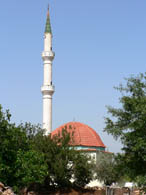
Little mosque in the village |
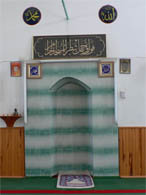
Little niche in the little mosque |
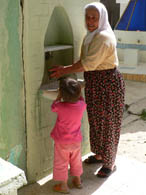
Washing in the public fountain |
After the mosque experience, we walked through this modest little village (population about 600). We saw the kids coming home from school, women preparing food, goats, tractors and rustic farmhouses.
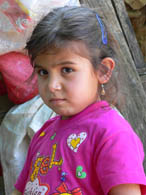
Village kid |
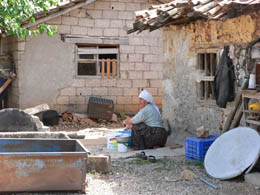
Village neighborhood |
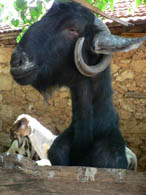
Another kind of village kid |
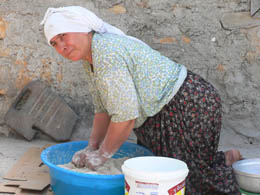
Mama hard at work |
Next we were led, like lambs to the slaughter, to the local carpet-weaving center. A pudgy guy told us about the carpet-weaving process, cotton, silk, wool, and number of knots per inch. The best wool comes from the back of the sheep because it has more lanolin. We were melting in the hot sun in the courtyard, looking at the looms and learning how long it takes to weave a rug. Next, they invited us into a large air-conditioned room with rugs on the wall. We sat on the padded comfortable benches and were served refreshing drinks of our choice. Then the show began, or was it the heavy sale’s pitch? A couple of guys began throwing carpets around on the floor. We were invited to touch the carpets and get involved. Bill and I kept our distance (along with the Belgium couple), but Joan ended up buying a very expensive rug. She was having buyer’s remorse and heart palpitations the rest of the tour. Elizabeth bought a couple of rugs for her grandsons. Bottom line, we were a successful group for the local carpet guys and generated a nice commission for our tour guide as well.
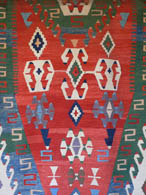
Carpet design from this area |
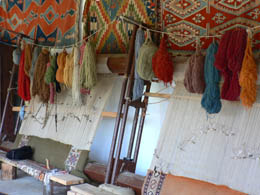
Looms with yarn overhead in a hot courtyard |
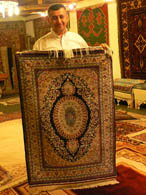
Let the show begin |
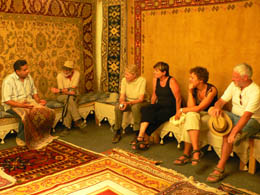
You must have this one! |
Last stop of the tour was at the beautiful Duden waterfall and picnic area set within a Turkish National Park. We only spent about 30 minutes there and then headed back to Antalya.
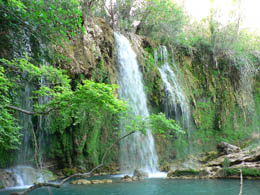
Duden Waterfall |
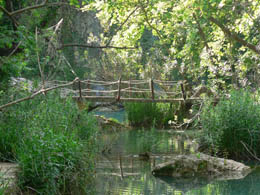
Dashed through the serene, peaceful place |
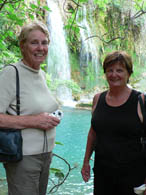
Joan and Elizabeth (our new Aussie friends) |
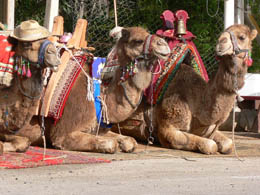
Waiting to take you for a ride |
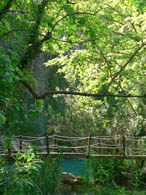
Beautiful place |
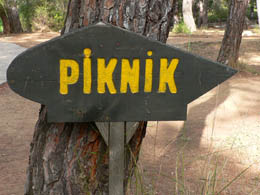
Picnic area this way |
At 6:30 pm, we said good-bye to our new friends and then dashed back to the White Garden for a quick shower and beer. (Although we had checked out of the hotel, they gave us fresh towels and let us use some rooms to shower that had not yet been made up.) No time for dinner before another shyster taxi driver got a piece of us. At first the driver said it would cost 50 lira to take us to the otogar (bus station). That was ridiculous, so we told the driver to take us to the nearby bus stop where we could catch a free shuttle to the otogar. Then he said he’d take us to the otogar for 12 lira, a major discount from his original 50. We agreed, but when we got to the otogar he charged us what was on the meter—14 lira. We grudgingly paid, but didn’t give him a tip.
The bus station was like an airport—a big, fancy place with ticket counters, shops, and cafes. We stopped to buy a bottle of water and the woman said water costs 15 lira (about $12). Bill said that’s ridiculous and then we went next door and bought a bottle for 1 lira. Always someone trying to rip you off.
We had a chicken gyro and salad in the café. Not very tasty, but quick, filling and cheap. We got on our overnight bus to Goreme, which left right on time at 8:30. The bus was quite nice with seats that reclined, and an attendant that served snacks—water, coffee, tea, cookies, and cakes. The ride would have been lovely except for the girl behind us who coughed all night, a horrible lung-rattling cough. Too dark to read, I popped a sleep enhancer. We had one bus stop where I sleep walked to the bathroom. Slept most of the night until the bus rolled into Goreme at 6:30A.M., right on time. |











